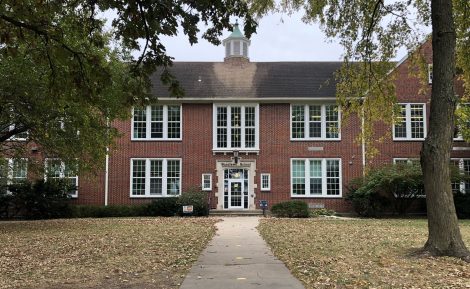With $3.3 million in ARPA funds, Tenants to Homeowners will start working toward 69 new units of affordable housing

photo by: Journal-World
The west side of the Douglas County Courthouse, 1100 Massachusetts St.
Tenants to Homeowners received one of the largest slices of the latest round of federal pandemic relief in Douglas County, and that money will eventually help create nearly 70 units of affordable rental housing.
During their American Rescue Plan Act allocation process last month, county leaders granted the local housing nonprofit’s entire $3.3 million request — the second-largest amount of ARPA funding granted to any agency in Douglas County. Of that total, $2.3 million will help the agency acquire 15 sites where it plans to eventually develop 69 units of supportive service housing for people currently experiencing or at risk of homelessness. The remaining $1 million in ARPA funding will cover the cost of rehabilitating existing structures on those sites.
The agency’s executive director, Rebecca Buford, told the Journal-World Friday that one of the project’s goals is to change people’s perspective on what affordable housing looks like. Buford said there’s often a perception that affordable housing looks like larger homes that are built to house an entire large family, but the buildings in this project will be smaller in size.
“(We want to) kind of move the needle on what we consider sustainable, good housing — that it doesn’t have to be a giant rancher,” Buford said.
The ARPA dollars won’t even account for half of the total cost of developing those housing units, though. Buford said the project will take a total of $7.3 million. When you factor in the ARPA funding, that means the nonprofit will still have to come up with $4 million to fund the project. Buford said the plan is to use other sources of federal funds, grants, the agency’s revolving project funds, and any other housing funding it can find.
But once the project is done, Buford said the new housing units would be truly affordable. Out of the 69 units, 29 of them will be rehabilitated from housing units that already exist. For the rest, the nonprofit is aiming for durable, tiny homes that it wouldn’t have to borrow any money to build. Buford said that would mean Tenants to Homeowners could charge less in rent, because it wouldn’t have to make up ground on mortgage payments.
The housing won’t just be affordable — it will provide wrap-around support services for people who were experiencing or at risk of homelessness, or people with disabilities or behavioral health concerns. Essentially, Buford said, that means integrating other local agencies’ assistance as part of the package for renters who might need it. That could mean working with agencies like Bert Nash Community Mental Health Center or DCCCA for behavioral health services, or Independence Inc. to help a renter with a disability arrange for transportation to and from work.
“Housing can be something that has really healthy, empowering ways to move someone to address some of their complexities and become more successful in our community,” Buford said. “It’s an opportunity for us. I truly believe after 22 years of doing this that we have this unique ability where there is a little bit of something wanted from us, which is safe and affordable housing, and it’s deserved. But we have the ability to say ‘Hey, we’re going to get you these supports,’ and that’s the nature of the deal.”
That’s not all, though. Other candidates who could benefit from supportive service housing might include young people who have aged out of the foster care system and need help to navigate living alone when they haven’t been given any guidance on that front before, Buford said. She said victims of domestic violence are also good candidates, especially those who may have escaped from a controlling situation where their partner didn’t let them engage in any of the interactions with their landlord.
It’s also a much more positive alternative to cycling through stays at the homeless shelter, Buford said, or the cost of keeping someone in jail when they might have been able to stay in the community if they had supportive service housing.
“If we put that same money into supportive service housing and allow them to be stably housed and work on issues and have the support to conquer addiction, move on from domestic violence situations, learn how to be independent and move out of foster care into independent living, those groups of people then become productive members of society,” Buford said.
The supportive service elements will come later down the line, and that’s because county leaders were especially interested in prioritizing one-time costs when allocating ARPA funding. As a result, Buford said it made more sense for that funding to cover one-time building acquisition and construction costs.
It’ll be a while before any new construction starts, Buford said; the rehabilitated units will likely be ready to lease a lot sooner. That aside, the nonprofit is still ironing out its land acquisitions to begin with.
“Tenants to Homeowners is 100% committed to building as many units — if we can build more, we will — as we can on these sites,” Buford said.







